|
|
FARM 13 / STICK MARSH FISHING REPORTS
FOR THE MONTH OF JANUARY, 2005
January 31, 2005
In our special Stick Marsh update of 22 January, we indicated that a way might have finally been found to locate the bass in our grass-less habitat. The first report you will see below this introduction verifies that, and it does it in spades.
The bass of the Farm 13/Stick Marsh impoundment started to spawn in late December and will continue to do so through approximately the end of February. They have had some very strong cold fronts and unusual cold weather to deal with so far. A hard wintry blast pushes them back from the shallow spawning locations and into adjacent deeper water. In our case, our waters are very murky due to the lack of grass to filter out the suspended particles in it. That means you and I cannot see the bass beds. It also means that the bass must spawn very shallow to assure the eggs get sufficient sunlight to properly hatch them. This means that the fish are spawning in about three feet of water, or less. And, that means they are on the west side of the Stick Marsh section and on the shallowest submerged levees elsewhere. When a cold front comes in, they drop back to the 6-8 foot waters nearest to the chosen spawning locations.
We have now found some of these spawning areas and the drop-back positions. Even though they can’t be seen, we know we are on these areas because the bass are there. They are somewhat reluctant to chase an artificial, but that is normal during the spawn. Usually, repeated casts have to be made to a bed until the bass becomes agitated enough to finally try and kill the intruder. Not knowing exactly where to cast in the first place makes repeated attempts a moot point.
But, live wild shiners are entirely another thing. They are real, they are food, and they are always a threat to eat the bass eggs. The bass knows they are real and will get that shiner very quickly.
So, we have located some areas holding bass. We have been using shiners almost exclusively. And, boy, do they work. Just ask the Nelson crew from West Virginia in the report below.
January 28, 2005
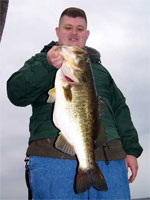 That winter cold finally got to the Nelson clan from Point Pleasant, WV. That winter cold finally got to the Nelson clan from Point Pleasant, WV.
Leon, his brother Lowell, and Lowell’s son Dave made the long drive straight through to soak up some Florida sunshine and chase some of those giant Stick Marsh bass. They went back home with pretty good sunburns and a trophy bass experience for each of them. So, I think it was a ‘Mission Accomplished’ experience.
The plan was to fish three days in a row, with each being a half-day outing. We targeted the afternoon, in that we knew the sun would warm the water and make the bass much more active in the latter half of the day.
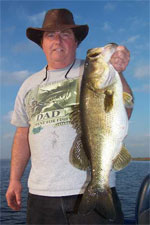 Our first fishing location was the north end of the Stick Marsh. With a pretty hefty westerly wind chopping the water a bit, we set up the boat 50 feet out from the north levee and floated the shiners 3 feet down under bobbers. After repositioning the boat about four times, we located some fish (Stan Daniel had also been fishing the location earlier, so we were not surprised the fish were there). We caught ours in a bit different location than Stan did, but we were still very close to his area. These were good solid fish and took the shiners well. A few bullhead catfish also bothered the shiners, but that is part of the game. Dave caught the first bass and then went dry. Lowell and Leon kept on catching. At this spot, Leon latched onto our first giant bass, a 9-lb. 4-oz trophy. From the size of her huge swollen belly, it was obvious that the fish was ready to spawn.
Our first fishing location was the north end of the Stick Marsh. With a pretty hefty westerly wind chopping the water a bit, we set up the boat 50 feet out from the north levee and floated the shiners 3 feet down under bobbers. After repositioning the boat about four times, we located some fish (Stan Daniel had also been fishing the location earlier, so we were not surprised the fish were there). We caught ours in a bit different location than Stan did, but we were still very close to his area. These were good solid fish and took the shiners well. A few bullhead catfish also bothered the shiners, but that is part of the game. Dave caught the first bass and then went dry. Lowell and Leon kept on catching. At this spot, Leon latched onto our first giant bass, a 9-lb. 4-oz trophy. From the size of her huge swollen belly, it was obvious that the fish was ready to spawn.
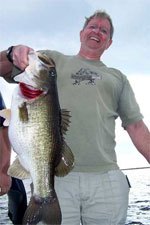 On the 2nd day, we found that a visiting angler had claimed our previous day’s honey hole. He had seen us catching well on the spot the 1st day, plus we talked with him a few minutes and gave him some advice. He took our advice, and our hole. But, the place has a lot of bass and a lot of fishing spots, so we went off to find one.
On the 2nd day, we found that a visiting angler had claimed our previous day’s honey hole. He had seen us catching well on the spot the 1st day, plus we talked with him a few minutes and gave him some advice. He took our advice, and our hole. But, the place has a lot of bass and a lot of fishing spots, so we went off to find one.
Our next good location was in Farm 13 on a shallow shell bed. We free-lined the shiners over this submerged levee location with good success. Lots of bass were taken, with Lowell getting the 2nd big bass of the trip. It also appeared primed and ready to spawn. Leon continued to do well and Dave started making a comeback. But, after two days of fishing, Dave still had nothing over 4 lbs. That would change.
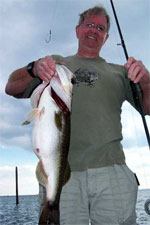 On our 3rd afternoon out, we found our 1st day’s honey hole vacant. But, the bass were also vacant. So, we went from spot to spot, trying to find a concentration. Finally, we elected to play the odds and went back to the first day’s honey hole. On our 3rd afternoon out, we found our 1st day’s honey hole vacant. But, the bass were also vacant. So, we went from spot to spot, trying to find a concentration. Finally, we elected to play the odds and went back to the first day’s honey hole.
That turned out to be a good move. Due to the direction of a rather stiff wind, we fished the location a bit differently. But, once again, it produced fish. This time, it was Dave’s turn to come up with the giant bass. It was a beauty, but did not quite overtake Leon’s for giant of the trip.
We really had a blast fishing with the Nelson’s. They were ‘good folks’. And, you might call them lucky, too. They managed to get home without the big Georgia ice storm blocking their path.
January 21 2005
Glenn Bolten and Neville Pennington wanted crappie. Crappie is often spelled ‘Kennansville’. So off we went.
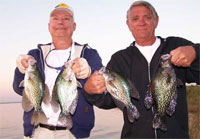 This was a perfect day to chase the Kennansville slabs – light breezes and warm weather. Our only problem started out to be that we could not locate any fish along the grass lines. We were just coming out of a strong cold spell with high northeasterly winds, so that would explain why they were not shallow on the grass. All your friendly guide could figure was that they were hunkered up on the bottom in the canals waiting for the water to warm back up. So, I told Glenn and Neville to ‘have faith and trust your guide’. Once it gets to mid-afternoon, the water will warm and the fish will move back in.
This was a perfect day to chase the Kennansville slabs – light breezes and warm weather. Our only problem started out to be that we could not locate any fish along the grass lines. We were just coming out of a strong cold spell with high northeasterly winds, so that would explain why they were not shallow on the grass. All your friendly guide could figure was that they were hunkered up on the bottom in the canals waiting for the water to warm back up. So, I told Glenn and Neville to ‘have faith and trust your guide’. Once it gets to mid-afternoon, the water will warm and the fish will move back in.
We continued to work both the grass lines, as well as drag some minnows in the deeper sections on the border canals. Outside a couple of keepers and some throwbacks, it was slow. They, sure enough, mid-afternoon arrived. And with it, the guide’s prediction.
At 3:00 PM, we started to get the papermouths taking live minnows shallow along the grass. You had to put that minnow right back against or in the grass, too. If you were a few inches outside the vegetation, you could forget it. As I working the trolling motor to ease along the grass line for the anglers, I picked up the trusty PERFECT Crappie Jig (cinnamon, w/blue tail, this time) and started working a parallel retrieve out from the grass about 4-6 feet. Once I had caught a couple, Neville picked up his light spinning rod and tied on a jig, too. He said that was his favorite way to fish for them. It didn’t take him long to catch one, either.
By the time the sun started to glow red in the west, we had a pretty good mess of crappie in the livewell. What had started out as a slow day turned into a pretty fair one. That just proves that persistence and 'clean living’ pay off!! (It also helps to keep the jigs and minnows wet at all times, too.)
January 20, 2005
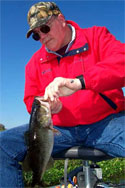 Brothers Phil and Jeff Semones were old friends, having fished with us in January 2004. That was trip of the unseasonable weather phenomenon, in which we had hailstones covering the boat. Talk about being a bit scary ----! THAT was somewhat unsettling, to say the least. Brothers Phil and Jeff Semones were old friends, having fished with us in January 2004. That was trip of the unseasonable weather phenomenon, in which we had hailstones covering the boat. Talk about being a bit scary ----! THAT was somewhat unsettling, to say the least.
This trip down from the Atlanta area brought the brothers beautiful clear skies, but lots of wind and cold temperatures. So, we opted to take some shiners down to the Farm 13 spillway and fish the eddy waters caused by the light flow from the pipe.
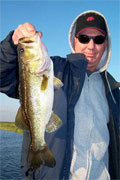 This was a hard day to start. The water was just barely running and it appeared most of the feeding fish had dispersed. But, it loosened up and finally got better. We were positioned against a grassy bank where the water split from direct flow downstream to a slight eddy back to the pipe. Depending on where you were in the boat, you could fish either part of the moving water. We used bobbers, for the most part. But, a free-lined shiner would also draw a strike.
This was a hard day to start. The water was just barely running and it appeared most of the feeding fish had dispersed. But, it loosened up and finally got better. We were positioned against a grassy bank where the water split from direct flow downstream to a slight eddy back to the pipe. Depending on where you were in the boat, you could fish either part of the moving water. We used bobbers, for the most part. But, a free-lined shiner would also draw a strike.
Neither angler ever got a giant bass or even had one on. Most were decent, solid fish just made for ‘catching’.
January 18, 2005
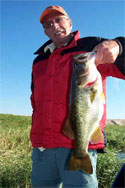 Norm Abramson is retired and spends part of the winter in his condo in the Ft. Lauderdale area. His son, Peter, lives in the Atlanta area. Norm went north to visit with Peter and family for the holidays. When it was time to go back to Florida, Peter decided to drive dad back. (Me-thinks I smell an excuse to go fishing.) Norm Abramson is retired and spends part of the winter in his condo in the Ft. Lauderdale area. His son, Peter, lives in the Atlanta area. Norm went north to visit with Peter and family for the holidays. When it was time to go back to Florida, Peter decided to drive dad back. (Me-thinks I smell an excuse to go fishing.)
Sure enough, I got a call from Peter saying he wanted to get in a day on the Marsh for he and Norm. And, a good day it was, too.
Cold, clear and windy --- just what was about the normal condition for most of January. Bundled up, we set out with a well full of shiners and went south.
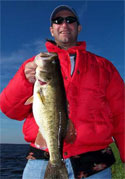 Stopping on a couple of choice locations, we did poorly. The fish either were not ‘home’, or just did not want to cooperate.
Stopping on a couple of choice locations, we did poorly. The fish either were not ‘home’, or just did not want to cooperate.
Soon, we found ourselves down in the SE corner of Farm 13 at the spillway. Here, there was a bit of running water from the pipe. So, we set up on a good eddy location and floated shiners under bobbers. Peter let his track downstream with the current, while Norm and I tried out the eddy flow. I did my checking with a free-lined shiner. The bass started out really good right away, with both anglers catching fish. Then, it started to slow. I stayed with my free-lined shiner and continued to get bit. Whenever that happened, I simply let the fish go on an open bail and handed it to one of the anglers.
Pretty soon, Norm decided that the free-line thing had merit and we rigged his outfit in the manner. As time and fished passed, Norm gradually developed his own technique, which proved to work very well. He simply fished his shiner directly under the boat on a short line. By adding a split shot, the shine could be coaxed into staying down near the bottom. I am not sure how many Norm caught way, but it was a good number.
No giant bass came to the boat this day, but a number of really good bass were taken. Norm got the ‘biggie’, which is way it was supposed to be.
Nice folks and a great day on the water. Do I have good job, or what??
A SPECIAL STICK MARSH UPDATE - January 22, 2005
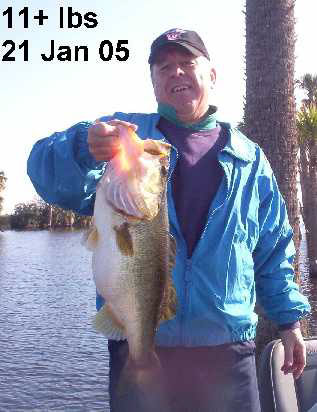 It may be that two of the core guides of the Stick Marsh/Farm 13 impoundment have found the ‘magic key’ to finally getting back to catching the lunker bass. It may be that two of the core guides of the Stick Marsh/Farm 13 impoundment have found the ‘magic key’ to finally getting back to catching the lunker bass.
With no grass left after the hurricanes, the impoundment has been tough (more like T-U-F-F). But, maybe Stan Daniel, aided by Hugh Crumpler, has found the secret (at least for the present)! We have all been running, gunning and crying, try to find where those danged bass are and where they will be on a predictable basis. Hugh guessed at it, based on his extensive depth of knowledge of bass and their spawning habits on the Stick Marsh. He passed it on to Stan. Stan, who was already working on the same idea, tied it all together. And, it appears the two may have been 100% correct.
And, some guide service customers do, too!
Stan took an overflow party out for me a week ago. He had a 9+ lb. fish, a 6+, plus some others in the quality range. This past week, he guided his Friday party to an 11-lb. giant, an 8+, and a couple of 6+ bass. These trips are NOT the normal 50-60 fish-a-day outings. But, they are turning high quality bass and some of those Stick Marsh giants!
They key elements to the success have been wild shiners (they apparently will NOT chase an artificial in these locations), canal levees on the west side of the Farm 13 and the levees on the north side on the Stick Marsh. These are natural draws for spawning bass, in that the powerful NE and north winds of winter cold fronts affect these locations the least.
As we progress and learn more, we’ll let you know what is found.
For now, you can always ask Stan (shd126@adelphia.net), Hugh (bsncoach@gate.net) , or myself (jporter@stickmarsh.com) for the latest information. DON’T come to the Stick Marsh on your own without assuring that the fish can be found. That lack of grass will doom your trip, in most cases!! Hiring a reputable guide for a day is your best bet.
January 15, 2005
Recent fishing results by a lot of visitors to the Farm 13/Stick Marsh have been disappointing, to say the least. But, I have repeatedly informed everyone that I could that ALL THE GRASS IS GONE. Vamoosed, vanished, gone south, and whatever else mean ‘IT AIN’T THERE ANYMORE’. A few of us have held on by the skin of our teeth and a bit luck from knowing the place intimately enough to come up with something innovative. But, the fact is, if there is no moving water at the pumps or spillway, it is anyone’s guess where to catch a lot of bass in the place. You can find singles running and gunning. And, if you get lucky, you may run across a school. But, for predictable fishing, it’s got to be moving water and shiners. No, they are NOT on the wood, or at least they don’t appear to be. That pattern is not much at all. I have found a few back in the 2-3 foot shallows. But, they are there to spawn and who knows where they will go after they finish that ritual.
And, if you think finding bass is hard with no grass, just imagine all the frustrated crappie chasers. That is really a grass-dependent exercise. I have moved ALL my crappie guiding to Kennansville Lake and have been very, very successful. But, I sure hate that 60 miles drive each way.
I guess I’ll make my fishy predictions for the New Year today. It may be interesting to look back next year and see just how close we guessed.
Bass will continue to be hard to find in the Stick Marsh all year, UNLESS they finally decide to relate to the wood. We hope that happens after the spawn.
The remnants of the underwater grasses have roots emerging on them, so we know they will re-root and grow again.
There will be NO grass on the surface until the summer of 2006; only underwater beds that are emerging.
The anglers who are OBSERVANT AND WATCH FOR EMERGING GRASS on the bottom will be on GREAT FISHING, as those grasses will draw the baitfish and predators in mass.
By the end of summer 2006, the grass beds will have reached the surface and fishing will have returned to normal.
There will be a major reduction in the 2005 spawn quantities. Without the cover and protection of the grass beds, the spawn crop of all species will be extremely vulnerable to predators and will suffer significant losses.
January 12, 2005
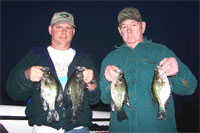 Scott Beach called and said his Father, Nelson, was coming down from Rome, NY, for a warm-up and a visit. As neither had ever caught crappie, Scott wanted to give that a try. Scott Beach called and said his Father, Nelson, was coming down from Rome, NY, for a warm-up and a visit. As neither had ever caught crappie, Scott wanted to give that a try.
Kennansville was our target that day. After getting minnows at the Kennansville Country Store (and, only store), we turned off the famous Cow Palace Café and headed down the 10-mile dirt road to the ramp.
In no time at all, we were on fish and we caught them in three ways. First, we fished the minnows under bobbers about 18-inches deep along and in the grass adjacent to the canals. Then, we added a couple of tight-line ‘cheater’ poles off the canal side of the boat and dragged minnows at about 7-feet down. Both worked very well. We caught more crappie on the deeper drifting minnows, but we also caught our small ones that way. So, I expect the catch comparison of in the grass vs. out in the deep water was about equal.
TODAY’S TIP FOR DRIFTING MINNOWS: Crappie is a social fish – they school a lot in open water. They are also one of the few fish in which the school stratifies by depth. Most fish schools can be envisioned as looking like a sphere, whereas a crappie resembles a dinner plate when viewed from the side. Nearly all of the crappie will be at the same depth. Accordingly, we must ALWAYS attempt to determine that depth for optimizing our catch rate. When drifting minnows in open water for crappie, boat control and lure/bait presentation are very key issues towards finding and maintaining that productive depth.
The speed of the boat should always be slowwwwww, but we all know it will vary a bit due to wind, current, and human factors. When the boat speed varies, the depth of the minnows may vary due to the line’s resistance to the water. To maintain a constant depth with the minnows when moving at varying speeds, ALWAYS weight the line heavily. That will keep the minnow down there. I use three large split shots about 8-inches above the hook. That allows the minnow some room for fish-attracting motion, but keeps the depth constant.
While Scot and Nelson worked on the crappie with minnows, I kept the big Blazer right along the grass lines. Of course, I also tossed to PERFECT Crappie Jig (cinnamon, w/chartreuse tail) out into the canal, out off the grass line. This proved well that the crappies were in the grass, in the depths, and just about everywhere in-between.
Even after releasing a LOT of small crappie, the Beach crew still wound up with about 38 nice ones that were bound for the dinner table.
January 10, 2005
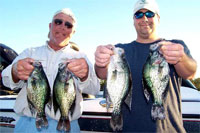 Bob Shepherd let us know that he had a friend, Chris Moloney, coming down from Alaska for a visit. Bob let us know that he was an old hand at fishing, having been a guide and charter boat operator in the Florida Keys for many years. But, he also said that he had never done much freshwater fishing and had never caught any crappie. Plus, Chris was new to crappie, as well, having lived in the far north all his life. He indicated they would like to catch some big crappies and soak up a bit of Florida sun. I recommended Kennansville for the best opportunities and Bob accepted. Bob Shepherd let us know that he had a friend, Chris Moloney, coming down from Alaska for a visit. Bob let us know that he was an old hand at fishing, having been a guide and charter boat operator in the Florida Keys for many years. But, he also said that he had never done much freshwater fishing and had never caught any crappie. Plus, Chris was new to crappie, as well, having lived in the far north all his life. He indicated they would like to catch some big crappies and soak up a bit of Florida sun. I recommended Kennansville for the best opportunities and Bob accepted.
It was certainly one of the nicer days of the entire year, so far. The breezes were light and the sun warm. And, the best part was that the crappie accommodated us.
Our first stop was a possible schooling spot where we hoped to get some jig action. That was a big flop, so I supposed the crappie were still keying to the shallow grass.
Rigging up our 12-foot fiberglass poles with bobbers and minnows, we set the depth at about 2-feet on Chris’ outfit and 18-inches on Bob’s. It actually made little difference in the depths set, as the crappie would grab the minnow almost immediately as it hit the water. Our only problem, at the start, was that there were not too many crappie on the stretch of grass we had selected. When we got bit, it was immediate. But, there just weren’t enough bites.
So, the World’s Luckiest Guide decided on a location that had been pretty poor up until today. But, we knew someday soon it would get better as the spawn progressed. Maybe today was that day.
It was!!
We probably fished only a 60-75 yard stretch of grass, but it held a LOT of fish, both crappie and bluegills. On our first pass, we elected to go with the PERFECT Crappie Jig. Everyone had a different color – Chris used the Gray Ghost and Bob had a chartreuse, w/blue tail. I tossed a cinnamon, w/blue tail out into the open water, while the crew tossed at the grass and reeds.
After one short pass, it became apparent that the intermittent reed stands that mixed with the shoreline grass was much more productive that grass alone. Possibly, that was because we could get the jigs back into the reed growth, whereas the grass alone was so thick as to restrict us to its outer edges. We also discovered a LOT of bluegill mixed in with the crappie.
TODAY’S TIP ABOUT SPWNING CRAPPIE LOCATIONS: It is quite common to find hordes of bluegills and Shellcrackers in an area where crappie are spawning. And, it becomes a good sign for locating the spawning areas for the observant angler. Bluegills eat the crappie eggs, as well as the small fry when they finally hatch. Watch for the grasses or reeds to quiver as the fish move through them. Spawning crappie will move slowly as they expel their eggs, so the grass motion will be slight. But, when bluegill are also present, you will see a lot of sharp grass action as the crappie try to chase the darting bluegills away.
We switched to the minnows and bobbers for a pass through the area and found we caught crappie along both the grass and reeds about equally. Dragging a couple of minnows on the canal side of the boat in the deeper water also produced.
I am not sure how many fish were caught. I expect that, counting the small throwbacks, there could have been 50-60. The 30+ big crappie kept for the table filled a shiner bag, though.
January 7, 2005
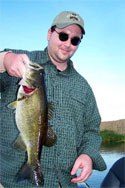 Chuck Terry and his son, Chris, flew down all the way from a cold, cold Milwaukee to fish the Stick Marsh with us. Chuck’s Prime Directive was “Let’s catch a big ‘un.” I wrote that in red pen on my calendar – yep, gotta try and get these guys a big bass. Chuck Terry and his son, Chris, flew down all the way from a cold, cold Milwaukee to fish the Stick Marsh with us. Chuck’s Prime Directive was “Let’s catch a big ‘un.” I wrote that in red pen on my calendar – yep, gotta try and get these guys a big bass.
It did not take us long to figure out that the lack of grass and th4e ever-increasing winds were going to force us to make early use of the shiners we carried. We tried a couple of spots on the submerged levees, but then here came an early wind.
We made our way to the SE corner of Farm 13, in hope of finding just a bit of moving water. The lack of any rain since Christmas had about stopped most moving water locations in their tracks. However, we had some bad luck and some good luck.
The bad luck was that the spillway had been permanently closed for maintenance on the sliding gate section. That effectively eliminated my two really good locations that had worked so well for giant bass for the recent Fawcett and Wilke parties (see the 31 Dec 04 and 3 Jan 05 reports, respectively).
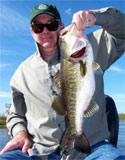 The good news was that they Water Management District folks had compensated for closing the spillway by opening one of the three pipes on the east side of the basin. While the water levels were not high enough for significant flow, the small pipe concentrated the meager flow and made it acceptable.
The good news was that they Water Management District folks had compensated for closing the spillway by opening one of the three pipes on the east side of the basin. While the water levels were not high enough for significant flow, the small pipe concentrated the meager flow and made it acceptable.
Another boat was sitting right on top of the pipe, though, fishing directly in its flow. They were catching bass on free-lined shiners, though most appeared small (later, these would get a bit larger). We looked the area over, with the understanding that a light water flow ALWAYS meant the eddies had a high potential for big bass. It was easy to pick the proper location, as the grass and leaves floating on the surface showed us exactly where the water doubled back and where it flowed straight on down the basin.
We started off with a bang, with free-lined shiners being inhaled in a rapid fashion. Good bass came to the boat and were released. Shiners were really catching the dickens. This action continued for awhile and then began to slow a bit. Chuck found an effective way to continue his catch rate by fishing his shiner in 10 feet of water directly under the boat. And, whenever a school passed through, everyone would be onto bass. We had a few catfish and mudfish come to partake of our offerings, as well.
After the other boat ran out of shiners and left, we also tried fishing directly in the current flow of the pipe. This produced some bass. But, we found it best to present the shiners just off to the side of the main flow to be most effective. All in all, our eddy water location proved to be the best for size.
Chuck got him a ‘big old good ‘un’, just like he asked for. Chris had to settle for second, but I don’t think that was bad considered the numbers of fish he caught. And, he wasn’t in that 17 degree weather in Milwaukee!!
January 7, 2005
2005 is off to a flying start at both the Stick Marsh (that trophy bass wonderland) and Kennansville Lake (our fine crappie lake).
Plus, the weather has been totally wonderful after one heck of a cold Christmas holiday period. How can you beat 74-78 degrees and sunshine every day?? I know it won’t last, but it sure fine while it does.
Once again, I remind you that there is NO grass left in the Stick Marsh. Bass fishing is very, very tough on artificials and just about as tough using wild shiners. With no grass to reference, it is tough to decide even where to fish. My hopes are that the bass will move to the wood in the Stick Marsh and the south end of the Farm as they complete spawning. If they don’t, we will still be faced with 6800 acres to open water in which to find those critters. Be sure to consider this when thinking about a long trip down here. If you plan to bring a boat and fish for a few days, by all means get a guide for at least ½ day to get you started off right.
January 3, 2005
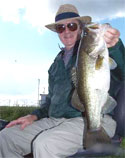 Another Father and son team climbed into the big BLAZER bass boat this day. Dave Wilke is a local resident now, while his son, Curt, resides in Alexandria, VA. Curt had called and said he was driving Dad back to FL from VA after a holiday visit. Curt would have one day before he flew back north and wanted to fish.
Another Father and son team climbed into the big BLAZER bass boat this day. Dave Wilke is a local resident now, while his son, Curt, resides in Alexandria, VA. Curt had called and said he was driving Dad back to FL from VA after a holiday visit. Curt would have one day before he flew back north and wanted to fish.
We decided to try artificials a bit, but carried a good supply of shiners, too. Bouncing around from shellbed to shellbed, we discovered a few bass. But, we could not seem to locate a good concentration. So, we decided to go try the shiners.
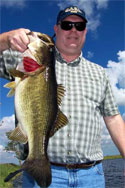 There was a decent flow of water at the Farm 13 spillway. It was not enough to keep the fish in front of the gate, but it was fine for locating them in eddy current locations.
There was a decent flow of water at the Farm 13 spillway. It was not enough to keep the fish in front of the gate, but it was fine for locating them in eddy current locations.
TODAY’S SPILLWAY FISHING LESSON: When the water at the SE spillway is running hard and clean, the bass will gather in front of it, often chasing the baitfish right on top. When the flow is slow or just a dribble, we can expect the best fishing to be down from the gate and along the side eddies. The eddy flow may be so slight as to be hard to discern, so you may have to watch materials floating on the surface to find them. This is a free-lining situation, so leave the bobbers in the box.
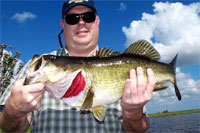 We rigged the shiners in a free-lining manner, using only a hook and no weight. Dave was in the front of the boat, while Curt was in the back. The bass agreed to cooperate with the shiners and the bite went from the front of the boat to the back of the boat on a regular basis. Both anglers got their big bass, with Curt taking giant bass honors.
We rigged the shiners in a free-lining manner, using only a hook and no weight. Dave was in the front of the boat, while Curt was in the back. The bass agreed to cooperate with the shiners and the bite went from the front of the boat to the back of the boat on a regular basis. Both anglers got their big bass, with Curt taking giant bass honors.
The action slowed after a while, so we opted to go try another location. As we motored up the east side of Farm 13, I noted the pump house was running. So, we wheeled in and anchored just off the flowing water.
Taking the same free-lining shining rigs, we tossed the hapless baitfish out into the current and let it take them across the high ground behind the blowout hole. A LOT of BIG fish were caught by both Dave and Curt in this spot. The problem was that the largest ones were catfish. There were bass taken, too. But, I had never seen the catfish up on this shallow area, as they usually reside down in the depths of the blowout hole. It made for some exciting times, just waiting to see if the giant fish was a bass or cat. A few were so big that even the heavy shiner equipment wouldn’t handle them and lines got popped.
It wasn’t long before the shiner supply finally ran out and we called it a day. I am sure glad we caught the big bass before we got on those catfish!!
January 1-2, 2005
We took a small break over New Years to clean equipment, do some maintenance, and find a few more fish for the guide service. One thing we found on the afternoon of 1 Jan 05 was that the crappie in the infamous C-54 canal (runs along the dirt road to the Stick Marsh) has a LOT of crappie in the reeds and grass along its edges now. Minnows a foot deep under bobbers were the ticket.
On the 2nd, we re-checked Kennansville. There they were – right back in that grass. We’d had Kathleen Lawson and her brother, Jamie, there for crappie a few days earlier (see report below) and the fish were really scarce for us. But, I guess that’s fishing. Our next trip to Kennansville for crappie is 12 Jan 05 with Scott Beach and I hope the fish are still hugging that grass.
December 31, 2004
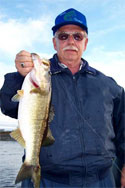 Bart Facwett called and said his son, Brad, was going to be down for the holidays. Bart wanted to make a fishing trip a Christmas present to Brad, plus to get him thawed out a bit. Brad is from Toledo, OH, and that’s a cold puppy this time of year!!! Bart Facwett called and said his son, Brad, was going to be down for the holidays. Bart wanted to make a fishing trip a Christmas present to Brad, plus to get him thawed out a bit. Brad is from Toledo, OH, and that’s a cold puppy this time of year!!!
These two guys were a real pleasure to fish with. I don’t think the bass were too happy with them, but I really enjoyed our time on the water. And, Brad finished out 2004 with a real fishing bang!!
We took a load of shiners and headed to Farm 13, with hopes of finding moving water. The east side pump was not running at all. But, the SE spillway had a slight water flow.
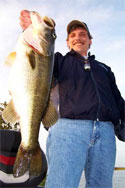 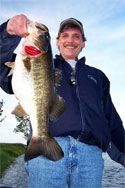 We found an eddy and moved against a shoreline well down from the gate. The shiner rods were rigged with a #3/0 hook directly to the FIRELINE. I usually hook shiners through the bottom lip and a nostril hole when bobber fishing. But, for free lining, it is best to hook the shiner just behind the dorsal fin. They will swim away from you and down when hooked that way.
We found an eddy and moved against a shoreline well down from the gate. The shiner rods were rigged with a #3/0 hook directly to the FIRELINE. I usually hook shiners through the bottom lip and a nostril hole when bobber fishing. But, for free lining, it is best to hook the shiner just behind the dorsal fin. They will swim away from you and down when hooked that way.
The shiners did their job and Bart got his wish – Brad was in motion setting hooks and battling big bass so much that he thawed very quickly. Bart caught his share of fish, but this day belonged to Brad. He got one real giant bass and a number of others that were in the true ‘big bass’ category. The pictures of his best two fish speak for themselves.
I wish every fishing day were as enjoyable as this one was.
December 29, 2004
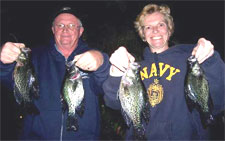 Kathleen Lawson and her brother, Jamie, wanted some crappie. I figured we’d go to Kennansville and get ‘em. We’d had a decent catch there two days earlier with Jim and Barry Keller, so I was enthused we could even improve on the Keller’s catch. Kathleen Lawson and her brother, Jamie, wanted some crappie. I figured we’d go to Kennansville and get ‘em. We’d had a decent catch there two days earlier with Jim and Barry Keller, so I was enthused we could even improve on the Keller’s catch.
That’s what I get for thinking.
This crappie trip was ruff, spelled R-U-F-F. The weather was great, the water was fine, and the conditions had not changed a bit from the day the Kellers and I were there. But, the fish sure were not present in the grass edges we worked. Counting the throwbacks and those lost, I am not sure we even saw more than 15 crappie. We did manage enough for a good meal, but it was not anything like Kennansville Lake usually produces.
The crappie are, of course, still there. We just did not fish where they were, obviously. The same two people who were in the canal near the boat ramp when we were with the Keller’s were there again. I wonder if that should tell me something. We’ll let you know in a future report.
December 27, 2004
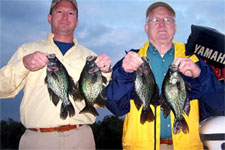 A soon as we wrapped up the Christmas festivities, the Father and son team of Jim and Barry Keller joined me on a trip after Kennansville crappie. It was a good trip, but not a ‘great’ trip. A soon as we wrapped up the Christmas festivities, the Father and son team of Jim and Barry Keller joined me on a trip after Kennansville crappie. It was a good trip, but not a ‘great’ trip.
The crappie were, in fact, right where we had expected them to be – right in the grass. No doubt, they were on the verge of spawning, as their bellies looked like they had swallowed a walnut. But, we made a few side excursions before going to the grass to fish.
We started out looking for schooled open-water crappie on a structure feature in the east canal. We hoped to do jigs on the ultralight rods and we also decided to set out a couple of minnow poles, as well. We worked this location for 20 minutes without even a bite. Actually, that was a good sign, in that is sort of confirmed that they were probably in the grass, rather than in the open water.
The south and north canals fared no better for open water fish, either. However, we did see two dedicated souls working the north canal near the ramp and they never moved all day. It is very possible they had something working.
We selected a canal that ran in the direction of the wind, thus allowing me to hold the boat parallel to the grass lines with the trolling motor. This kept both anglers in close enough o fish. Moving to the edges of the grass, we set up the 10-foot fiberglass poles with eight feet of light mono, a #2 gold wire hook, a split shot, and a small one-inch (diameter) foam bobber. We set the bobbers 18 inches above the hook, where we impaled small minnows through the tail.
TODAY’S PERCH JERKIN’ FISHING LESSON: In this type of live bait presentation, we are swinging the bait into pockets and holes in the grass. So, it is important that we have good control in order to place the minnow on target, while not getting hung up. To do this properly, always use the heaviest split shot that will still allow the bobber to float. That weight is like a pendulum and its mass equates into your ‘feel’ of the rig and ability to control it properly. If it is windy and you are still having control problems, move to a larger bobber and a correspondingly larger weight. The fish really don’t care much about the rigging – just the minnow!!
The water at the outer edge of the grass was about 2.5-3 feet deep, becoming a bit shallower in the pockets closer to the bank. We eased along 50 feet without any action. Then, there they were and the bobbers began to dip. We worked approximately 100 yards of this grass line, finding the fish a bit scattered along it. I watched the shoreline, both in front of and behind us, making mental note of certain features that would give us reference to fish locations. The first one was a lone small cypress tree behind us, directly across from a section that gave up six quick slabs. Another was a clump of reeds on a stretch that seemed to have a small concentration of fish. When we stopped getting bites or catching fish, we would go back to the reference points and fish those areas again.
Our fishing worked for a couple of dozen nice crappie and a number of throw-backs that we hoped would grow up to be the next World’s Record.

Today's Weather for
the Stick Marsh Area
Past Stick Marsh Fishing Reports
Farm 13 / Stick Marsh Information Guide
Email questions to jporter@jimporter.org.
|
Recommended sites by The Fishin' Tipster |
A common question that we get: "Is there somewhere close to get bait and tackle?" This is where we get our bait.

Pete and Tina Heinz / 9 South Mulberry St. / Fellsmere, FL 32948 / 772-571-9855
Get your site listed here
Let us help you drive more targeted traffic to your site.
|


Rank our Site
©Copyright 2001-07 All rights reserved by Jim Porter, any reproduction, quotation or other use of this site or its elements is prohibited without the express written permission of Jim Porter
|
|


 FROGG TOGGS RAIN GEAR
FROGG TOGGS RAIN GEAR
THE BEST PRICES AVAILABLE!!


|
|







